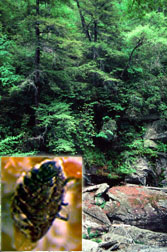This page has been archived and is being provided for reference purposes only. The page is no longer being updated, and therefore, links on the page may be invalid.
| Read the magazine story to find out more. |
 New hybrids of the native eastern hemlock that can survive the invasive insect woolly adelgid are being bred by ARS scientists and their collaborators. Photo of eastern hemlocks courtesy of Paul Bolstad, University of Minnesota, Bugwood.org; inset photo of hemlock woolly adelgid courtesy of Michael Montgomery, Forest Service, Bugwood.org. |
|
|
Potential Hemlock Hybrids Tolerant to Invasive Hemlock Woolly Adelgid
By Stephanie YaoNovember 10, 2010
New hemlock hybrids that are tolerant to the invasive insect known as hemlock woolly adelgid have been created by U.S. Department of Agriculture (USDA) scientists.
Geneticist Richard Olsen and horticulturist Sue Bentz of USDA's Agricultural Research Service (ARS) teamed up with Forest Service entomologist Mike Montgomery to breed and select these tolerant hybrids. Olsen and Bentz work in the U.S. National Arboretum's Floral and Nursery Plants Research Unit in Beltsville, Md. The arboretum is located in Washington, D.C., and is operated by ARS, the principal intramural scientific research agency of USDA.
Over the past few decades, two hemlocks native to the United States—Tsuga canadensis and Tsuga caroliniana—have been under attack by the small sucking insect Adelges tsugae, also known as the hemlock woolly adelgid (HWA). Originally from Asia, this aphid relative has spread to forests and backyards in 17 eastern states, killing hemlock trees and devastating natural ecosystems.
Under the direction of ARS geneticist Denny Townsend (now retired), the arboretum began a breeding program in the 1990s to develop hemlock hybrids tolerant to HWA. The scientists crossed hemlock species native to the United States with germplasm—collected in Asia—of hemlocks that have shown tolerance to the insect. Now, 10 years later, Olsen and Bentz have developed 140 hemlock hybrids, 108 of which are suitable for testing.
In 2006, Olsen and his colleagues began a multi-year field trial to test each hybrid's degree of tolerance to HWA. Testing more than 170 trees, the researchers artificially infested the hybrids by attaching HWA-infested branches to the hybrids' lower branches and securing them with mesh bags to prevent the insects from escaping. They found the species T. chinensis and its hybrids to be most tolerant to HWA.
Details of the scientists' studies have been published in the Journal of Economic Entomology, the Journal of Arboriculture and the Journal of the American Society for Horticultural Science.
The hybrids are appealing not only due to their tolerance, but because they have good vigor and shape. Still, the researchers have several years of testing to complete before they can release these hybrids.
Read more about this research in the November/December 2010 issue of Agricultural Research magazine.
